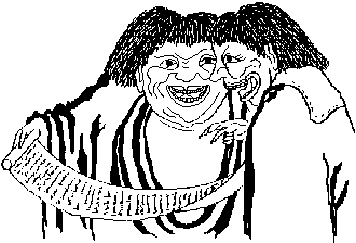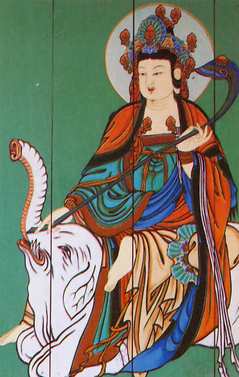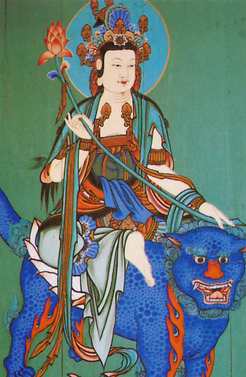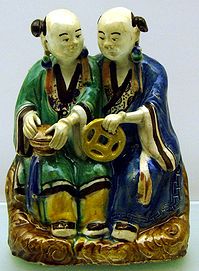Hé 和 & Hé 合 = two conspicuously harmonious young men
Big Stick (Fēnggān 丰干) = a nameless Buddhist/Daoist poet living in a monastery
Poet of Cold Mountain (Hán Shān 寒山)= another one (possibly a Hé), living outside the monastery
Shídé 拾得 = a discarded son; monastic skullery; poet (possibly a Hé)
Wànhuí or WÀN Huí万回 = a magical spirit (or not) (possibly a Hé, maybe even two)
Some people think Hé and Hé were two brothers, surnamed HÉ 和, who were especially harmonious (hé 合), even when they were children. They never fought or disagreed with each other, and so they became famous throughout the land, and were assumed to have been immortals from the start (since normal brothers don’t get on that well) or to have become immortals later (based on their amazing ability to get along together).
Other people think they were two young men with the surnames HÉ 和 and HÉ 合, who were fabulously compatible, and gained fame because of that, although of course most people don’t gain fame merely for being compatible.
Still other people —perhaps more imaginative ones— think there is more to it than that. One of the two, they say, is probably a famous Táng 唐 dynasty (period 12) poet. The poet was a reclusive type, and perhaps a puckish one, and no one ever learned his proper name, so he is usually called the Poet of Cold Mountain (Hán Shān 寒山). That is a silly name, of course, which serves him right for keeping his real name so secret.
Cold Mountain had a friend named Big Stick (Fēnggān 丰干), the story goes. They both loved writing poems and sipping tea and thinking about philosophical conundrums that were a little bit Buddhist and a little bit Daoist. So they became Zen monks, since Zen is the kind of Buddhism that is most Daoist. But their ways were different.
One day, as Big Stick was walking between the monastery and a nearby village he came upon a ten-year-old boy who had been abandoned by his parents for being unsatifactory in some way. So Big Stick took him back to the monastery, where he was put to work in the kitchen. They called him Shídé 拾得, which meant “foundling” because they never figured out where he came from, or what he had done to merit abandonment.

Shídé may have been an unsatisfactory son, but he was very talented (as unsatisfactory sons sometimes are), and he proved to be an excellent scullery lad, a quick study in Buddhism, and a fine companion to Big Stick and Cold Mountain as they sipped tea and thought about Buddhism and Daoism and the mountains meeting the sea. Because the monastery was in Tiāntái 天台 county, they were sometimes called the Tiāntái Trio by other poets, although of course, Tiāntái is another school of Buddhism, so the term may not have been well received in Zen circles.
Big Stick was often occupied with monastic austerities and monastic affairs. But over time, young Shídé and the much older Cold Mountain, despite their difference in age, became inseparable friends. Shídé would save kitchen scraps to feed Cold Mountain, and Cold Mountain’s visits became more and more frequent. They wrote each other poems that sounded alike. They spent more and more of their time together. And they became the very model of harmony.

Later Buddhists sometimes claimed that Shídé was actually an avatar of the bodhisattva Pǔxián púsà 普贤菩萨 (Samantabhadra, also called Visvabhadra), associated with Buddhist orthodox teaching and often shown riding a white elephant. Therefore in the Qīng 清 dynasty the Yōngzhèng 雍正 emperor (reign 21a-4, 1723-1735) gave him the title “Holy Enlightened and Salvationist Disciple HÉ Shídé” (Miàojué Pǔdù Hé Shèng Shídé Dàshì 妙觉普渡合圣拾得大士), and so ordinary Buddhists sometimes call him “Saint Hé” (Hé Shèng 合圣).

Of course, if Shídé was the avatar of a bodhisattva, clearly Cold Mountain was also one, in his case of Wénshū pŭsà 文殊菩萨 (Mañjuśri), the leader of all the bodhisattvas because of his astonishing wisdom, who is often shown riding a blue lion. Accordingly the emperor gave him the title “Holy Enlightened and Salvationist Disciple Cold Mountain HÉ (Miàojué Pǔdù Hé Shèng Hánshān Dàshì 妙 觉普渡和圣寒山大士),” and so ordinary Buddhists sometimes call him “Saint Hé” (Hé Shèng 和圣). The two saints —Hé and Hé or Pǔxián and Wénshū or Samantabhadra and Mañjuśri— are rarely depicted singly, for they were such excellent friends in life.
It is confusing to have two saints —Hé and Hé— with what sounds like the same name, but they are always together, and so Buddhists call them “Two Saints Hé and Hé” (Hé-Hé Èr Shèng 和合二圣). Of course that is pretty much like calling them “Two Immortals Hé and Hé” (Hé-Hé Èr Xiān 和合二仙) as everybody else does, except that it is understood to be Buddhist.
Indeed, their harmony with each other was so great that some people in later generations even think they were a single person, a magical spirit they call Wànhuí or 万回, or “Return From Ten Thousand.” Some people made up a story saying that WÀN Huí was a little boy with the surname WÀN, or else that Wànhuí was a little boy with the surname ZHĀNG 张.
Either way —WÀN Huí or ZHĀNG Wànhuí— he is said to have been born in 632 in Wénxiāng 阌乡 county in Hénán 河南 province. When he grew old enough to carry out the mission, his family dispatched him to the distant city of Ānxī 安西 (modern Xī’ān 西安) in Shǎanxǐ 陕西 province to look for his older brother, who was in the army and was therefore feared dead. He traveled the huge distance to Ānxī and back in a single day, which astonished everbody even more than the news that his brother was still alive in spite of being in the army.
By Sòng 宋 dynasty times (period 15), he had come to be called the “Harmony Immortal” and was thought to help people, especially army people, return home to their families. By the Míng 明 Dynasty (period 20) his association with family unity had caused him to evolve into an immortal who assisted in happy marriages (although he carried a drum and his hair was unkempt, which doesn’t do much for most marriages).
But of course, this second story can’t explain why he is referred to as “Two Immortals.”

Artists often portray the two Immortals as long-haired monks, or as boys with childish side-locks, sometimes giggling together over a scroll with unimaginable contents. Sometimes one holds a lotus (also called hé 荷) and the other carries a Buddhist begging bowl, from which sometimes a rather un-Buddhist cloud of felicitous colored bats may rise.
The two are divine patrons of marital bliss, but they are also associated with money and are patron divinities for merchants, so they may be portrayed holding coins, or the three-footed toad associated with wealth (story link).
In view of their great friendship for each other, they are also considered to look after the welfare of friends and lovers. And given their mutual attraction and the times in which we live, nowadays a few people say they are also patrons of gay relationships.